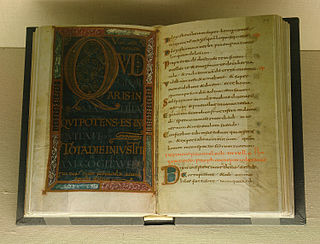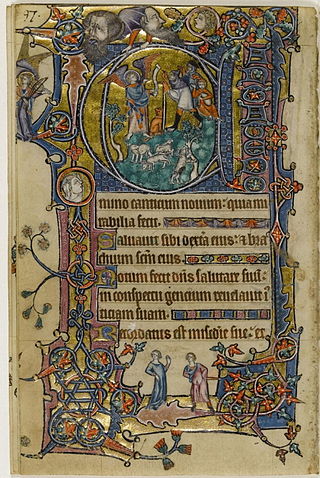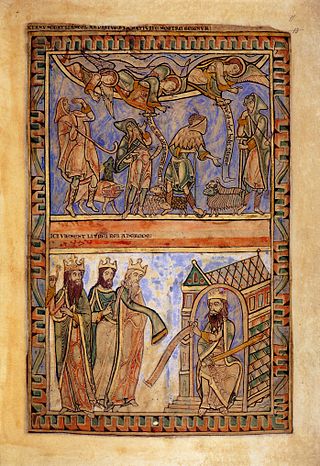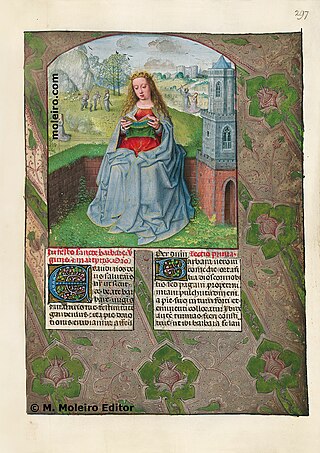
The Gorleston Psalter (British Library Add MS 49622) is a 14th-century manuscript notable for containing early music instruction and for its humorous marginalia. It is named for the town of Gorleston in Norfolk.

The Gorleston Psalter (British Library Add MS 49622) is a 14th-century manuscript notable for containing early music instruction and for its humorous marginalia. It is named for the town of Gorleston in Norfolk.


The Gorleston Psalter is richly illustrated, with frequent illuminations, as well as many bas-de-page (bottom-of-the-page) illustrations or drolleries as marginalia. [1]
The bulk of the manuscript is taken up by the psalms (foll. 8r–190v), which is preceded by a calendar (1r–6v, with twelve roundels) and a prayer (7v), and followed by a canticles (190v–206r), an Athanasian creed (206r–208v), a litany (208v–214r), collects (214r–214v), an Office of the Dead (223v–225v), prayers (223v–225v), a hymn (225v–226r), and a litany (226r–228r).
The prayer on fol. 7v, Suscipere dignare domine dues omnipotens hos psalmos quos ego indignus peccator, was added after the manuscript passed to Norwich Cathedral Priory, along with a miniature of the crucifixion on vol. 7r, as was the litany on foll. 226r–228r, similar to the litany in the Ormesby Psalter. There are thirteen large historiated initials, marking the beginning of Psalms 1, 26, 38, 51, 52, 68, 80, 97, 101, 109, 119, the beginning of Canticles, and the Office of the Dead (showing the funeral of a bishop), besides 145 historiated minor initials. The Beatus initial to Psalm 1 (a B for beatus), shows the Tree of Jesse surrounded by a border showing the arms of England and France (fol. 8r).
One famous image from the Psalter shows a fox carries a goose away in its mouth, while the goose says queck. The scene is probably an allusion to the tale of Reynard the Fox. [1] Armorial illustrations showing in the manuscript have been identified as those of Roger Bigod, (f. 70b), Gilbert Peche, (f. 86), and Aymer de Valence, (f. 107v). [2]
Written in Latin in at least three separate hands, the Psalter consists of the original text from its creation in around 1310, with a few later additions. [2] The added material is a prayer before the psalter on f.7b and an added litany, ff. 226b–228. The first hand in the manuscript is identified as being the scribe of the original work, with two later hands identified as being responsible for the additions c. 1320-1325. [2] The first of these two later hands has been co-identified with the text hand of the Stowe Breviary and Douai Psalter. [2] The third hand, that of the prayer on f.7b, is described as smaller and much more irregular and unsteady. [2]
Nigel Morgan, in his catalogue of a 1973 exhibition in Norwich, has drawn attention to stylistic similarities between the Gorleston Psalter and the Stowe Breviary, Douai Psalter, Castle Acre Psalter (Yale University Library, MS. 417), and the Escorial Psalter (Escorial MS. Q II 6.). [3] It is believed that the Gorleston Psalter is an earlier output from the scriptorum that later produced the Stowe Breviary, Douai Psalter, and the Escorial Psalter. [2] [4]

It is believed to have been made in the first quarter of the 14th century for someone associated with the parish church of St Andrew at Gorleston. This association is deduced from the inclusion of the Dedication of Gorleston Church on March 8 in the psalter's calendar. Dating of the manuscript is partially based on the omission of Thomas of Hereford from this calendar. Thomas was canonised in 1320, and his feast is noted in the Stowe Breviary and Douai Psalter whose calendars otherwise closely match the one in the Gorleston Psalter. [2] The earliest date has been derived from the arms of England and France, which are shown in association on the Beatus page, leading experts to conclude that it was not executed before the marriage of Edward I to Margaret of France in 1299. Cockerell [5] proposed a date of c.1306 for the manuscript based on an association of the repeated image of an elderly bearded layman with Roger Bigod, 5th Earl of Norfolk (died 1306), whose armorial shield appears on f. 70b close to one of the images of the layman. Other dates proposed include c. 1320 by N.J. Morgan, [3] and L.F. Sandler proposes a date of c. 1310 – c. 1320 arguing that the Bigod armorial refers to the Thetford Priory (which also used the arms) rather than Roger Bigod. [6]
The manuscript was originally owned by the church of St. Andrew, Gorleston, but passed to Norwich Cathedral Priory around 1320–25, where it is believed to have remained until dissolution in the Reformation. Following this it passed to the Cornwallis family, for which evidence of ownership is provided by an inscription of Sir Thomas Cornwallis (1519–1604) on the first folio, and an armorial bookplate of the family on the front pastedown. Following the death of Charles Cornwallis, 2nd Marquess Cornwallis in 1823 without male issue, the psalter was presented by his daughters to the Hon. Richard Griffin, 3rd Baron Braybrooke. Baybrooke was the husband of Jane Cornwallis, eldest daughter of the 2nd Marquis. To record this event an inscription was added to the first flyleaf, signed by Jane, Louisa, Jemima, Mary and Elizabeth Cornwallis, reading "This Missal originally the property of Sir Thomas Cornwalleys from whom it descended to the Daughters and Coheiresses of Charles 2nd Marquis Cornwallis was by them presented to the Honble Richard Neville as a token of their regard & affection 1823". In 1904 Henry Neville, 7th Baron Braybrooke sold the Psalter to C.W. Dyson Perrins, who later bequeathed it, with other manuscripts, to the British Museum (now the British Library).

A psalter is a volume containing the Book of Psalms, often with other devotional material bound in as well, such as a liturgical calendar and litany of the Saints. Until the emergence of the book of hours in the Late Middle Ages, psalters were the books most widely owned by wealthy lay persons. They were commonly used for learning to read. Many Psalters were richly illuminated, and they include some of the most spectacular surviving examples of medieval book art.

Books of hours are Christian prayer books, which were used to pray the canonical hours. The use of a book of hours was especially popular in the Middle Ages and as a result, they are the most common type of surviving medieval illuminated manuscript. Like every manuscript, each manuscript book of hours is unique in one way or another, but most contain a similar collection of texts, prayers and psalms, often with appropriate decorations, for Christian devotion. Illumination or decoration is minimal in many examples, often restricted to decorated capital letters at the start of psalms and other prayers, but books made for wealthy patrons may be extremely lavish, with full-page miniatures. These illustrations would combine picturesque scenes of country life with sacred images.

The Macclesfield Psalter is a lavishly illuminated manuscript probably produced c. 1320–30 in East Anglia. The psalter, or book of Psalms, contains 252 beautifully illustrated pages and is named after its most recent owner, the Earl of Macclesfield.

The term "Celtic Rite" is applied to the various liturgical rites used in Celtic Christianity in Britain, Ireland and Brittany and the monasteries founded by St. Columbanus and Saint Catald in France, Germany, Switzerland, and Italy during the early middle ages. The term is not meant to imply homogeneity; instead it is used to describe a diverse range of liturgical practices united by lineage and geography.

The Luttrell Psalter is an illuminated psalter commissioned by Sir Geoffrey Luttrell (1276–1345), lord of the manor of Irnham in Lincolnshire, written and illustrated on parchment circa 1320–1340 in England by anonymous scribes and artists.

The Stowe Psalter is a psalter from the "2nd or 3rd quarter of the 11th century", at the end of Anglo-Saxon art. The text includes the Gallican version of the Psalms, followed by the Canticles with an interlinear Old English gloss.

The Winchester Psalter is an English 12th-century illuminated manuscript psalter, also sometimes known as the Psalter of Henry of Blois, and formerly known as the St Swithun's Psalter. It was probably made for use in Winchester, most scholars agreeing that the most likely patron was the Henry of Blois, brother of Stephen, King of England, and Bishop of Winchester from 1129 until his death in 1171. Until recent decades it was "a little-studied masterpiece of English Romanesque painting", but it has been the subject of several recent studies.

Two lavishly illustrated illuminated manuscript psalters are known as the Psalter of Saint Louis as they belonged to the canonized King Louis IX of France. They are now in Paris and Leiden, and are respectively good examples of French Gothic and English Romanesque illumination.

The Psalter World Map or the Map Psalter is a small mappa mundi from the 13th century, found in a psalter. No other records of psalters found from the middle ages have a mappa mundi. The Psalter mappa mundi was likely used to provide context for the Bible's stories as well as a visual narrative of Christianity. A Mappa is a noun meaning napkin or cloth and mundi is an adjective referencing something clean or organized. Mappa mundis were not utilized as maps for travel or geographical education, but as history lessons taught through a visual means. Historian Felicitas Schmieder refers to mappa mundi as "Geographies of Salvation" as they are report the narrative of Christ's interaction with our world. The Psalter mappa mundi is now conserved at the British Library in London. An open-access high-resolution digital image of the map with place and name annotations is included among the thirteen medieval maps of the world edited in the Virtual Mappa project. The Map Psalter can be broken down in the following manner: ff. 3v-8r are later additions of 6 illustrations from the New Testament, ff. 9r-9v are the mappa mundi and a second written T-O map, ff. 10v-16v a calendar, which were included in many psalters of the time. They served to highlight days of canonization of saints and other important holidays, f. 17r-v has simple prayers usually found in psalters, ff. 18v-184v consist of the Canticles, or a collection of hymns, prayers, or songs usually found in psalters. ff. 184r-185v include a litany, ff. 185v-189v are petitions for help from God, ff. 217-221v induces the Office of the Dead, ff. 191r-212v are passages praising the Virgin Mary. The ff. 212r - 217r are written in Anglo-Norman, as all signs indicate that the book was made in London. The psalter ends on ff. 221v-222v with a different writing style of common Latin prayers, appearing to be a later addition.
The Stowe manuscripts are a collection of about two thousand Irish, Anglo-Saxon and later medieval manuscripts, nearly all now in the British Library. The manuscripts date from 1154 to the end of the 14th century.
The Stowe Breviary is an early-fourteenth-century illuminated manuscript Breviary from England, providing the divine office according to the Sarum ordinal and calendar.

Flixton Priory was a nunnery under a prioress following the Augustinian rule, which formerly stood in the parish of Flixton in the north of the English county of Suffolk, about 3 miles (4.8 km) south-west of Bungay. It was founded by Margery de Creke in 1258, and was dissolved in 1536–37. It was the poorest of the nunneries within the Diocese of Norwich. The site of the priory, which was enclosed by a moat, was at the present Abbey Farm, where little apart from the position in the landscape and a small section of standing wall remain to be seen. It was scheduled as an ancient monument in 1953. It is privately owned and is not open to the public. It is suggested that some parts of the masonry may have been re-used in St Peter's Hall at St Peter, South Elmham.
M. Moleiro Editor is a publishing house specialising in high-quality facsimile reproductions of codices, maps and illuminated manuscripts. Founded in Barcelona in 1991, the firm has reproduced many masterpieces from the history of illumination.

The Isabella Breviary is a late 15th-century illuminated manuscript housed in the British Library, London. Queen Isabella I of Castile was given the manuscript shortly before 1497 by her ambassador Francisco de Rojas to commemorate the double marriage of her children and the children of Emperor Maximilian of Austria and Duchess Mary of Burgundy.

The Howard Psalter and Hours is a 14th-century illuminated prayerbook. It includes a liturgical Psalter with canticles and litany, the Office of the Dead, a calendar of East Anglian origin and an incomplete Hours of the Passion. It was produced between 1310 and 1320. It is written in Latin in a Gothic script in two columns per page. There are 115 extant folios which measure 360 by 235 mm. The text block occupies an area of 250 by 166 mm. It is bound together with the De Lisle Psalter, a contemporary psalter.

The Petites Heures of Jean de France, Duc de Berry is an illuminated book of hours commissioned by John, Duke of Berry between 1375 and 1385–90. It is known for its ornate miniature leaves and border decorations.

A breviary is a liturgical book used in Christianity for praying the canonical hours, usually recited at seven fixed prayer times.

The Tiberius Psalter is one of at least four surviving Gallican psalters produced at New Minster, Winchester in the years around the Norman conquest of England. The manuscript can now be seen in full online at the British Library website.